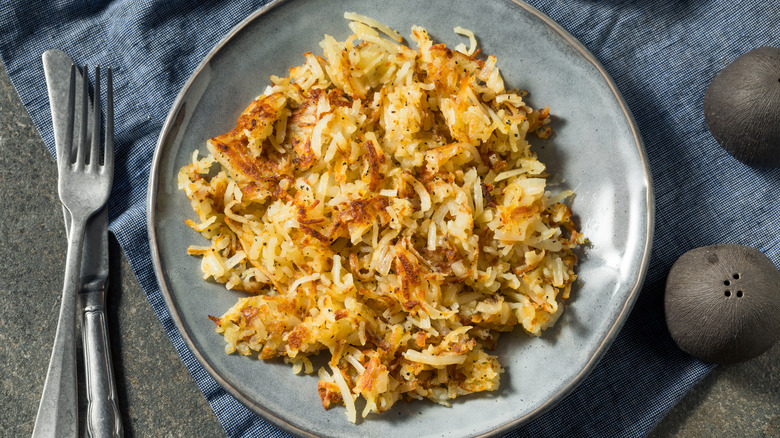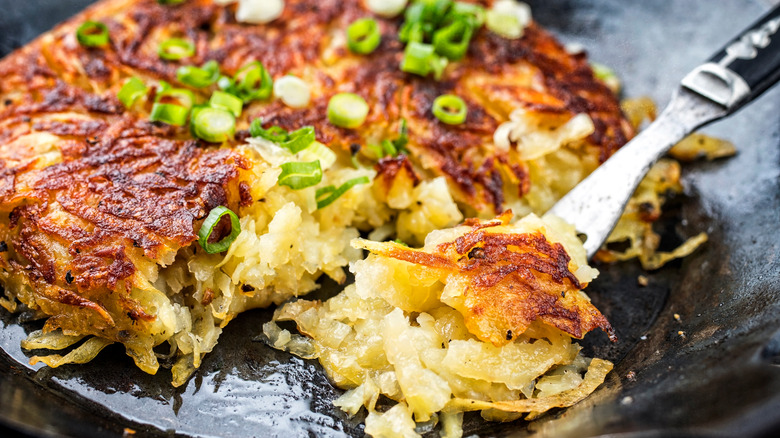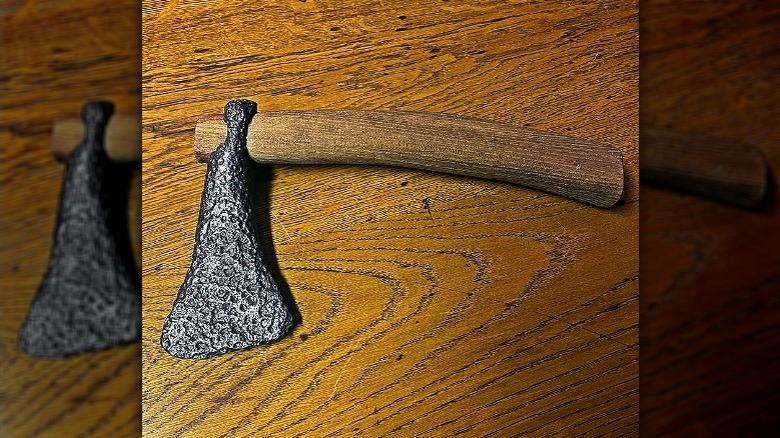The Surprising Dark Age Origins Of The Humble Hash Brown Name
When you fry potatoes, there's bound to be a little smoke. Perhaps that's why the history of hash browns is a little hazy. More realistically, though, it's likely hard to pin down the origin of hash browns because the dish has a very simple recipe. It's so straightforward, the first person to hash and brown potatoes probably didn't think to write it down. Still, it's possible early U.S. food service establishments, like railroad dining cars, served an early version of hash browns alongside their home fries.
However, somebody did eventually write about hash browns for the very first time in the "Minnesota Farmers' Institute Annual of 1835." That was merely a reference, though, and it wasn't until the 1880s that actual recipes were put into a cookbook: "Miss Parloa's Kitchen Companion: A Guide for All Who Would Be Good Housekeepers." That paved the way for New York hotels during the 1890s to start serving hash browns as gourmet breakfast dishes, and by the 1910s, hash browns made their way onto lunch counters, too. Once quick-service restaurants took over the American culinary scene in the 1950s, processed potatoes became the now-famous fast-food breakfast hash brown. But how was this particular name chosen?
Hashes and hatchets are linked
"Hash brown" is a fitting moniker, since chefs make this dish by hashing (cutting) and browning (frying) the potato. The background of the word "brown" is its own thing, but "hash" and the cutting tool known as "hatchet" are both etymologically derived from the French word "hache." In France, that term is used to refer to none other than a battle-axe, something infamous for slicing up organic material — if you catch our drift.
Eventually, a "t" was added to "hache" to refer to its smaller version. Meanwhile, an "r" was added to "hache" in French to form "hacher" — the French phrase for "chop." English speakers just modified "hacher" somewhat to create "hash." Strangely, though, it seems it took a few centuries for "hash" to be paired up with "brown."
According to The Washington Post, English speakers started saying "hash" in the 1600s, around the same time the French started making "hachis": chopped meat and veggies encircled by buttery, eggy, and puréed spuds. During the 17th century, for instance, "Martha Washington's Booke of Cookery" detailed a trio of meat-and-potato hash recipes, a type of dish eventually served at cheap "hash house" restaurants. Still, as mentioned, no one recorded hash browns, specifically — as in, just fried potatoes — until later on in the 19th century.
Battle-axes are a French innovation
There are some nifty things you'd never think to do with hash browns that can actually accomplish quite a lot in the kitchen. Hacking up your enemies with hash browns, though? Well, you probably want to leave that idea on the cutting room floor. Even so, bringing up such a connection at the breakfast table may allow you to entertain fellow diners with your sharp-minded knowledge. Plus, for anyone French, those battle-axes were once a cutting-edge technology worth being proud of.
To say axes and their smaller counterparts, hatchets, are age-old would be an understatement. These tools date back over 30,000 years to the Stone Age, but they were mostly used for chipping, piercing, and splitting objects back then. Originally made of wood and rock, axes gradually acquired metal components, making them more effective. Then, around 500 A.D., the first battle-axe, known in Latin as the "francisca," was wielded by the Franks, per the Warfare History Network. Its light yet sturdy design made it practical for use in warfare, but imagine using that to hash up brown spuds! Such a weapon is truly no small potato.


